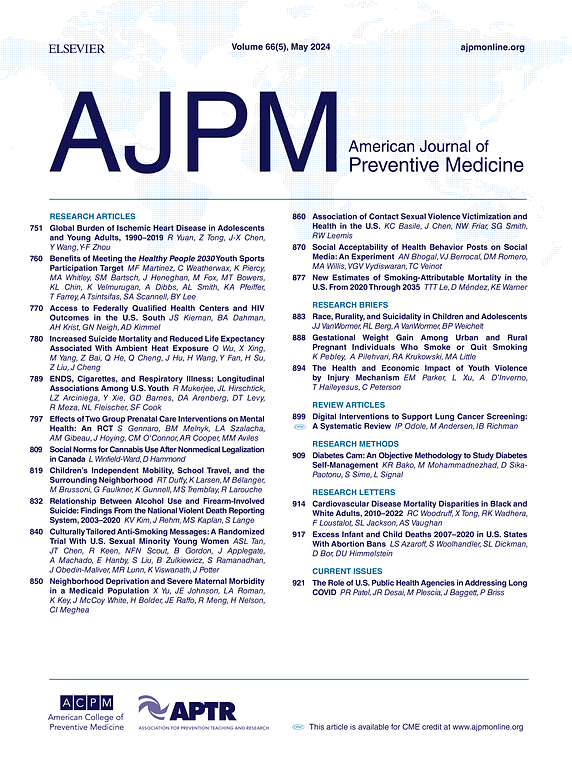Association of Precarious Employment With Unmet Healthcare Needs and Health Checkup Participation
IF 4.3
2区 医学
Q1 MEDICINE, GENERAL & INTERNAL
引用次数: 0
Abstract
Introduction
Precarious employment has emerged as a public health concern. This study explored the association between precarious employment and unmet healthcare needs and participation in health checkups.
Methods
This study analyzed data from a nationally representative sample of 12,215 wage workers, comprising a total of 65,405 observations, obtained from the Korean Welfare Panel Study (2008–2022). Precarious employment was characterized by insecure employment, inadequate wages, and lack of worker rights, and categorized into quartiles: lowest, low, high, and highest. The study focused on two outcomes: unmet healthcare needs due to financial constraints and nonparticipation in health checkups over the past year. Robust Poisson regression models were used to calculate prevalence ratios and 95% CIs under the framework of generalized estimating equations.
Results
Of the respondents, 0.7% reported unmet healthcare needs, while 44.2% did not attend health checkups. Compared with workers in the lowest precarious employment quartile, those in the high and highest precarious employment quartiles had a 5.83-fold (95% CI=2.73, 12.45) and 12.53-fold (95% CI=5.88, 26.70) increase in the prevalence of experiencing unmet healthcare needs, respectively. Similarly, compared to the lowest precarious employment quartile, those in the high and highest precarious employment quartiles had a 2.38-fold (95% CI=2.26, 2.51) and 2.92-fold (95% CI=2.77, 3.08) increase in the prevalence of nonparticipation in health checkups, respectively.
Conclusions
Precarious employment is associated with unmet healthcare needs and nonparticipation in health checkups. This study underscores the need for policies that improve healthcare access for workers in precarious conditions.
不稳定就业与未满足的医疗保健需求和健康检查参与协会。
不稳定就业(PE)已成为一个公共卫生问题。本研究探讨体育运动与未满足的医疗保健需求及健康检查参与的关系。方法:本研究分析了从韩国福利小组研究(2008-2022)中获得的全国代表性样本12,215名工资工人的数据,包括总共65405项观察结果。PE的特点是就业不安全、工资不足和缺乏工人权利,并分为最低、低、高和最高四分位数。这项研究的重点是两个结果:由于财政限制而未满足的医疗保健需求,以及过去一年未参加健康检查。在广义估计方程框架下,采用稳健泊松回归模型计算患病率(pr)和95%置信区间(ci)。结果:在受访者中,0.7%的人报告医疗需求未得到满足,44.2%的人没有参加健康检查。与最低PE四分位数的工人相比,高PE四分位数和最高PE四分位数的工人经历未满足医疗需求的患病率分别增加了5.83倍(95% CI: 2.73-12.45)和12.53倍(95% CI: 5.88-26.70)。同样,与最低PE四分位数相比,高PE四分位数和最高PE四分位数的人群不参加健康检查的患病率分别增加了2.38倍(95% CI: 2.26-2.51)和2.92倍(95% CI: 2.77-3.08)。结论:PE与未满足的卫生保健需求和不参加健康检查有关。这项研究强调需要制定政策,改善处于不稳定条件下的工人获得医疗保健的机会。
本文章由计算机程序翻译,如有差异,请以英文原文为准。
求助全文
约1分钟内获得全文
求助全文
来源期刊

American Journal of Preventive Medicine
医学-公共卫生、环境卫生与职业卫生
CiteScore
8.60
自引率
1.80%
发文量
395
审稿时长
32 days
期刊介绍:
The American Journal of Preventive Medicine is the official journal of the American College of Preventive Medicine and the Association for Prevention Teaching and Research. It publishes articles in the areas of prevention research, teaching, practice and policy. Original research is published on interventions aimed at the prevention of chronic and acute disease and the promotion of individual and community health.
Of particular emphasis are papers that address the primary and secondary prevention of important clinical, behavioral and public health issues such as injury and violence, infectious disease, women''s health, smoking, sedentary behaviors and physical activity, nutrition, diabetes, obesity, and substance use disorders. Papers also address educational initiatives aimed at improving the ability of health professionals to provide effective clinical prevention and public health services. Papers on health services research pertinent to prevention and public health are also published. The journal also publishes official policy statements from the two co-sponsoring organizations, review articles, media reviews, and editorials. Finally, the journal periodically publishes supplements and special theme issues devoted to areas of current interest to the prevention community.
 求助内容:
求助内容: 应助结果提醒方式:
应助结果提醒方式:


